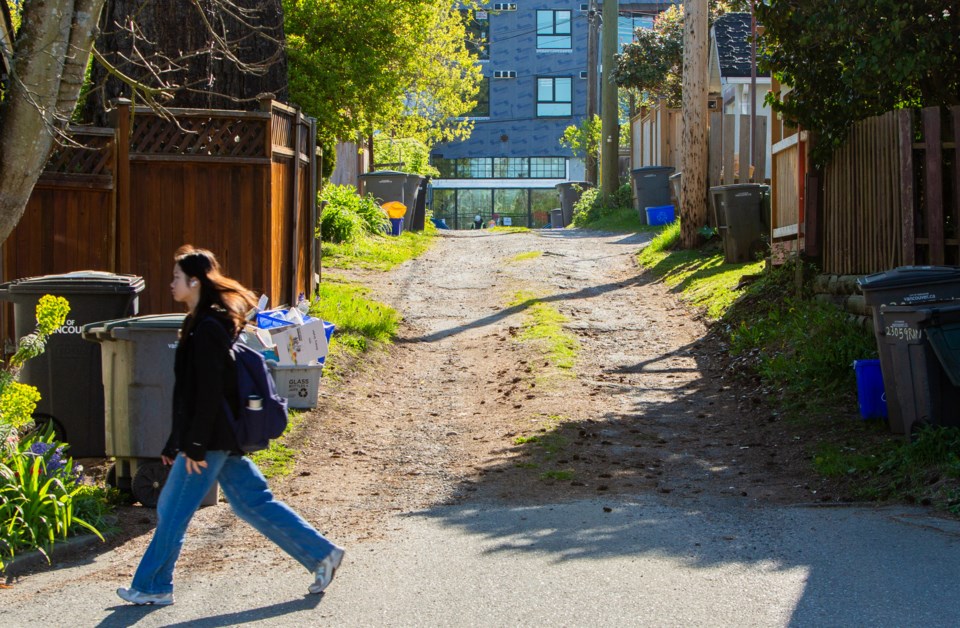The City of Vancouver has a backlog of 150 applications from residents who want their lanes paved, according to the manager of the city’s street design branch in engineering services.
Joyce Lee told city council in a recent presentation that it would cost an estimated $9 million for the city to eliminate the backlog. Currently, the city only paves about four lanes per year.
That’s because the city’s “local improvement program” has for several years required the city to pay 30 per cent of the cost for a project such as a paved lane. Property owners pay 70 per cent of the cost.
That means the total cost to clear the backlog — when combining what the city and property owners would pay under the 70-30 formula — is estimated at $30 million, with $9 million being the city’s portion.
The city does not have a dedicated capital budget for lane paving, although the engineering department allocates $200,000 annually towards the city’s cost-share portion of local improvement projects such as lanes and speed humps.
“Due to the limited funds available for the city's cost-share portion, this leads to very long wait times for residents,” said Lee, noting some residents can wait up to 10 years to have their application considered.
City council decided April 10 to change the funding formula in an effort to eliminate the backlog of applications. But those changes will now mean property owners will have to pay 100 per cent of the cost of getting a lane paved.
The requirement is not unprecedented, with other B.C. and Canadian cities having shifted to property owners paying 100 per cent of the cost. Property owners first have to circulate a petition in the neighbourhood to get two-thirds support for a lane to be paved.
$200K to pave lane
Staff believe the new funding formula will significantly reduce the backlog of 150 applications.
“This change would allow engineering to eliminate the backlog in property owners’ laneway paving requests within three to five years, since a lack of city funding would no longer delay [local improvement] projects from proceeding,” said a report that accompanied Lee’s presentation to council.
“After this three-to-five year period, wait times to access this program will be eliminated. “
The report said a conventional asphalt lane costs roughly $200,000 to pave, and a typical residential lane has approximately 30 abutting properties.
Under the 70 per cent cost share model, each property owner would pay roughly $4,500 per property. Property owners have the option to pay a one-time lump sum or have the cost amortized over 15 years.
Under the new model, property owners wishing to have a lane paved would see an average lump sum increase of $2,000 for conventional asphalt paving. The cost would reach $3,700 to $4,600 for a lane that includes green rainwater infrastructure.
That type of infrastructure, which includes installing gravel trenches or using the equivalent of perforated manholes, aims to improve the city’s management of rainwater runoff in lanes.
'Country lanes'
Vancouver has previously experimented with so-called “country lanes,” where two narrow concrete strips run the length of the lane, making it durable for vehicles to pass by. The area between the strips is covered in plastic grid pavers, allowing grass to grow.
Council heard that the country lane experiment, which was launched at three locations in 2003, was a success.
“They reduced urban heat islands, added green space, engaged the community and were very permeable — at least initially,” said Robb Lukes, the city’s branch manager for green infrastructure in the streets division.
Lukes said there are a variety of reasons why the city hasn't built more.
“The country lanes were more than double the cost of conventional paving,” he said. “And given the multiple materials and multi-step process and construction, there are no easy ways to bring down that cost significantly.”
That’s why, he added, the city has shifted to experimenting with porous asphalt, gravel trenches that run down the middle of a lane and dry wells. He pointed to a lane near Harriet Street, where the city installed a trench.
“It was cheaper to install the infiltration trench rather than trying to service this laneway with an extension to the sewer system,” said Lukes, noting the lane had previous drainage problems.
“Over the past two years, we have not seen any overflows from this infiltration trench and that includes for [rain] events that were over 48 millimetres.”
Vancouver has 1,050 kilometres of local roads and 720 kilometres of lanes.
During discussion in the council chamber, councillors Pete Fry and Christine Boyle asked staff whether it was necessary to continue paving lanes.
Lee: “It's not a high priority for us right now due to the amount of people it serves. However, if you ask the general public and the residents, they believe they do like their lanes being paved.”
Lon LaClaire, the city’s chief engineer: “Sometimes lanes get into such poor condition that we're repairing or doing minor repair so often that it does hit a point where it would make sense. For a lot of lanes that get very little use or don't have significant problems, there's no real need to pave them.”





